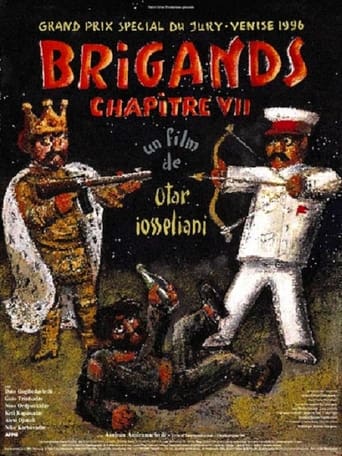Andres Salama
One of Director Otar Iosseliani's stronger films. The movie takes place during several periods of time in his native country of Georgia: in the Middle Ages, in the early 1900s, during the Stalinist period (the bulk of the movie) and in the chaos of the early 1990s. The same actors often play different characters at the different periods of time (for example, the guy playing the medieval king also plays a Stalinist henchman and a contemporary smuggler). The movie works through vignettes full of deadpan humor, and a common thread of all the stories seems to be the absurdity of life, the arrogance of power and man's inhumanity to man. Iosseliani even plays a couple of roles here, as a Stalinist torturer, and as a present day bumbling projectionist, in one of the film's most elaborate gags. Overall, a great movie, with Iosseliani's caustic humor telling us, as the old Latin proverb said, that homo homini lupus, man is a wolf to man.
igor_fedchenia
I am giving Brigands the highest mark. However, I believe it is virtually impossible to appreciate the movie without sufficient knowledge of Soviet history and perhaps some involvement into Perestroika and post Perestroika cultural context.The film is an antithesis to very famous movie by Tengiz Abuladze (also a Georgian as Iosseliani) Monanieba (Confession). The later was one of the first attempts to rethink and reevaluate the past involvements of all layers of society in Stalin terror. It was of special significance that a Georgian has made such a film because Stalin even until now possesses a status of icon in his home country. Confession took a stance that all that had happened was a great tragedy and everybody was guilty to have let it happened.Brigands, on the other hand, portraits the Stalin terror as something very mundane and boring, pushing a viewer to only one logical conclusion that it was unavoidable having in mind that authorities in all times had been no more than ordinary brigands, gangsters and robbers. Iosseliani uses the same cast to play historically parallel roles from medieval Georgia to the very recent events of collapse or the Soviet Union. The same actors and repeating at least in spirit parallel events create some static recognizable core in seemingly distant and different stories.The film appeals to various known historical facts such as personal Stalin involvement in criminal acts of bank robberies before Bolsheviks had noticed him.It is a masterpiece in both cinematographic and philosophic way.
a_drew_k
i suppose the trick while watching Ioseliani's movies is to take them just as they are. trying to conceptualize them as less as possible. movie figure out the ideas himself while head is tranquil and mind is open. the colors, the visual series seems to be rather not less important then the plot gimmicks and characters. and all together it's a very special flow if perception. personally i enjoyed it a lot. i really liked his way of seeing.
Grégoire "Freak" Dubost
if i hadn't seen his Otar Iosseliani's next film, 1999's masterpiece "Adieu, Plancher des vaches !". So my comment will probably be linked to the two films rather than only to this particularly strange journey, adrift in a Parisian's tramp mind. War is the main thread that links his dreams, as he embodies a medieval king, or a communist leader, or remembers of his east-european country, ravaged by war. But more interesting is the permanent obsession, for Iosseliani, of typical features like Cinema in itself, Paris, where the director actually lives (he's from Georgia), tramps, alcohol and songs. The scenes which I think are 'real' in opposition to 'dreamt' ones, mainly show the hero, with his unfortunate friends, but still happy singing beautiful harmonies. Just like the last scene (and others) from "Adieu,..". It is a bit difficult to follow the plot, since there are so many different ages edited together, but as the very first sequence shows us, this is only Cinema. So just let your mind wander with the pictures.
